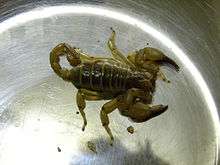Urodacus yaschenkoi
| inland robust scorpion | |
|---|---|
 | |
| Scientific classification | |
| Kingdom: | Animalia |
| Phylum: | Arthropoda |
| Subphylum: | Chelicerata |
| Class: | Arachnida |
| Order: | Scorpiones |
| Family: | Scorpionidae |
| Subfamily: | Urodacinae |
| Genus: | Urodacus |
| Species: | U. yaschenkoi |
| Binomial name | |
| Urodacus yaschenkoi (Birula, 1903)[1] | |
Urodacus yaschenkoi, commonly known as the inland robust scorpion, is a species of scorpion belonging to the subfamily Urodacinae (family Scorpionidae). It is native to central Australia.
The inland robust scorpion was described by Alexei Birula in 1903 as Hemihoplopus yaschenkoi.[1] It ranges across inland Australia from Birdsville on the border of southwestern Queensland and northwestern New South Wales across South Australia and the southern Northern Territory to Broome and Laverton in Western Australia.[2] The genus Urodacus was placed in its own family in 2000. Before this, the group had been a subfamily Urodacinae within the family Scorpionidae.[3]
Measuring up to 7 cm (2.8 in), it is one of largest species of scorpion native to Australia.[4] It has a red-yellow-brown carapace, with tergites, tail and pedipalps a darker red to red-black. Its underside and legs are brown-yellow. The male has a long tail, while the female has a short tail.[2]
The inland robust scorpion builds and resides in a spiral burrow in the sand. A field study near Broken Hill measured the burrows and found they all had the same basic structure: a sloping entrance chamber to a depth of 8–10 cm, followed by up to nine spiral turns leading to a lower horizontal terminal chamber. The depth of the burrow and number of spiral turns depended on the instar of the scorpion; the younger (2nd instar) scorpion burrows were 15–20 cm deep while those of the oldest (6th instar) scorpions reached a depth of around 100 cm. The scorpion digs by moving sand with its chelicerae and scraping it backwards under successive pairs of legs. The amount of sand removed can be 200–400 times its own weight.[5] Experiments showed inland robust scorpions could build burrows in 8–10 hours.[5]
It is found in arid regions of inland Australia in habitat such as sand dunes. Able to live 10–15 years in captivity, it is seen for sale in pet shops in Australia.[4]
References
- 1 2 Department of the Environment, Water, Heritage and the Arts (12 February 2010). "Species Urodacus yaschenkoi (Birula, 1903)". Australian Biological Resources Study: Australian Faunal Directory. Commonwealth of Australia. Retrieved 19 April 2014.
- 1 2 Koch, Lucien Everard (1977). "The taxonomy, geographic distribution and evolutionary radiation of Australo-Papuan scorpions" (PDF). Records of the Western Australian Museum. 5 (2): 83–367 [292–94].
- ↑ Department of the Environment, Water, Heritage and the Arts (9 October 2013). "Family Urodacidae". Australian Biological Resources Study: Australian Faunal Directory. Commonwealth of Australia. Retrieved 23 April 2014.
- 1 2 Henderson, Alan; Henderson, Deanna & Sinclair, Jessie (2008). Bugs Alive. Museum Victoria. p. 129. ISBN 0975837087.
- 1 2 Shorthouse, D.J.; Marples, T.G. (1980). "Observations on the Burrow and Associated Behaviour of the Arid-Zone Scorpion Urodacus yaschenkoi (Birula)". Australian Journal of Zoology. 28 (4): 581–90. doi:10.1071/ZO9800581.